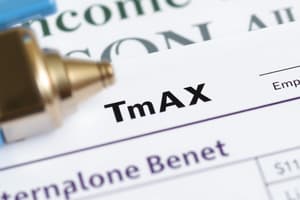Podcast
Questions and Answers
Capitalization is the process used to:
Capitalization is the process used to:
- Convert income into an estimate of value (correct)
- Establish reproduction cost
- Establish a depreciation schedule
- Establish mortgage payments
A loan secured by real property featuring an interest rate that is constant for the term of the loan is referred to as a(an):
A loan secured by real property featuring an interest rate that is constant for the term of the loan is referred to as a(an):
- Non-adjustable-rate mortgage
- Fixed-rate mortgage (correct)
- Adjustable-rate mortgage
- Constant amortization mortgage
The underlying principle providing the basis of the income capitalization approach is:
The underlying principle providing the basis of the income capitalization approach is:
- Anticipation (correct)
- Balance
- Conformity
- Change
The basic equation used in the income approach to value is:
The basic equation used in the income approach to value is:
A gross lease requires that, in addition to the rent, the tenant must pay:
A gross lease requires that, in addition to the rent, the tenant must pay:
When market rent exceeds contract rent, the difference is known as:
When market rent exceeds contract rent, the difference is known as:
The rental income that a property would most probably command in the open market is called:
The rental income that a property would most probably command in the open market is called:
The anticipated income from all operations of the property adjusted for vacancy and collection losses and miscellaneous income is called:
The anticipated income from all operations of the property adjusted for vacancy and collection losses and miscellaneous income is called:
If an income property has an annual effective gross income of $64,000 with total expenses of $30,000 and variable expenses of $17,000, what is the operating expense ratio?
If an income property has an annual effective gross income of $64,000 with total expenses of $30,000 and variable expenses of $17,000, what is the operating expense ratio?
In reconstructing an income statement for an apartment complex, you estimate that the potential gross income is $500,000. The vacancy and collection loss allowance is 6 percent. If operating expenses are $205,000, what is the operating expense ratio (rounded)?
In reconstructing an income statement for an apartment complex, you estimate that the potential gross income is $500,000. The vacancy and collection loss allowance is 6 percent. If operating expenses are $205,000, what is the operating expense ratio (rounded)?
The subject is an office building which contains 30,000 square feet of gross building area, and 24,000 square feet of net rentable area. The market rent for similar space is $15.00 per square foot of net rentable area. Vacancy and collection losses are 3% of potential gross income. Operating expenses are 32% of effective gross income, and the sales price was $2,793,600. What is the potential gross income?
The subject is an office building which contains 30,000 square feet of gross building area, and 24,000 square feet of net rentable area. The market rent for similar space is $15.00 per square foot of net rentable area. Vacancy and collection losses are 3% of potential gross income. Operating expenses are 32% of effective gross income, and the sales price was $2,793,600. What is the potential gross income?
The subject is an office building which contains 30,000 square feet of gross building area, and 24,000 square feet of net rentable area. The market rent for similar space is $15.00 per square foot of net rentable area. Vacancy and collection losses are 3% of potential gross income. Operating expenses are 32% of effective gross income, and the sales price was 2,793,600. What is the effective gross income?
The subject is an office building which contains 30,000 square feet of gross building area, and 24,000 square feet of net rentable area. The market rent for similar space is $15.00 per square foot of net rentable area. Vacancy and collection losses are 3% of potential gross income. Operating expenses are 32% of effective gross income, and the sales price was 2,793,600. What is the effective gross income?
The subject is an office building which contains 30,000 square feet of gross building area, and 24,000 square feet of net rentable area. The market rent for similar space is $15.00 per square foot of net rentable area. Vacancy and collection losses are 3% of potential gross income. Operating expenses are 32% of effective gross income, and the sales price was 2,793,600. What is the net operating income?
The subject is an office building which contains 30,000 square feet of gross building area, and 24,000 square feet of net rentable area. The market rent for similar space is $15.00 per square foot of net rentable area. Vacancy and collection losses are 3% of potential gross income. Operating expenses are 32% of effective gross income, and the sales price was 2,793,600. What is the net operating income?
The subject is an office building which contains 30,000 square feet of gross building area, and 24,000 square feet of net rentable area. The market rent for similar space is $15.00 per square foot of net rentable area.
Vacancy and collection losses are 3% of potential gross income.
Operating expenses are 32% of effective gross income, and the sales price was $2,793,600. What is the overall capitalization rate (Ro)?
The subject is an office building which contains 30,000 square feet of gross building area, and 24,000 square feet of net rentable area. The market rent for similar space is $15.00 per square foot of net rentable area.
Vacancy and collection losses are 3% of potential gross income.
Operating expenses are 32% of effective gross income, and the sales price was $2,793,600. What is the overall capitalization rate (Ro)?
A property has a net operating income of $10,000,
interest payments of $8,000, and principal payments of $1,000.
What is the debt coverage ratio?
A property has a net operating income of $10,000, interest payments of $8,000, and principal payments of $1,000. What is the debt coverage ratio?
Given the following information: Building capitalization rate: 0.11; Land capitalization rate: 0.09; Land value as a percent of total value: 35%. What is the overall capitalization rate by using the band-of-investment method?
Given the following information: Building capitalization rate: 0.11; Land capitalization rate: 0.09; Land value as a percent of total value: 35%. What is the overall capitalization rate by using the band-of-investment method?
The lease base rent less rent concessions is called:
The lease base rent less rent concessions is called:
The rate that is the percentage that annual real estate taxes are in relation to the property's total value is:
The rate that is the percentage that annual real estate taxes are in relation to the property's total value is:
The ratio of net operating income to effective gross income is called:
The ratio of net operating income to effective gross income is called:
The mortgage capitalization rate (RM) is the ratio between the payments of principal and interest on a mortgage to the original amount borrowed and is expressed:
The mortgage capitalization rate (RM) is the ratio between the payments of principal and interest on a mortgage to the original amount borrowed and is expressed:
What is the overall capitalization rate (Ro) from the following information developed from sales comparables in the area of the subject property? Potential gross income: $1,545,000; Operating expenses: $543,068; Vacancy and collection loss rate: 5%; Effective gross income multiplier: 7.0.
What is the overall capitalization rate (Ro) from the following information developed from sales comparables in the area of the subject property? Potential gross income: $1,545,000; Operating expenses: $543,068; Vacancy and collection loss rate: 5%; Effective gross income multiplier: 7.0.
You have determined that typical properties, like the subject you are appraising, are financed with 60% debt and 40% equity. Typical financing terms for this type of property require 8% of the amount borrowed be paid annually to amortize the loan, and the typical equity dividend rate (RE) is 0.11 for the equity investor. The effective tax rate for the jurisdiction is 2%. From this information, develop the overall capitalization rate (Ro).
You have determined that typical properties, like the subject you are appraising, are financed with 60% debt and 40% equity. Typical financing terms for this type of property require 8% of the amount borrowed be paid annually to amortize the loan, and the typical equity dividend rate (RE) is 0.11 for the equity investor. The effective tax rate for the jurisdiction is 2%. From this information, develop the overall capitalization rate (Ro).
A written document in which the rights to use and occupy land or structures are transferred by the owner to another for a specified period of time in return for a specified rent is:
A written document in which the rights to use and occupy land or structures are transferred by the owner to another for a specified period of time in return for a specified rent is:
The debt coverage ratio requirement from mortgage lenders is 1.5. Lenders will finance 80% of the investment and require a mortgage annual constant of 11.5%. What would be the indicated overall capitalization rate (Ro) for the subject commercial property?
The debt coverage ratio requirement from mortgage lenders is 1.5. Lenders will finance 80% of the investment and require a mortgage annual constant of 11.5%. What would be the indicated overall capitalization rate (Ro) for the subject commercial property?
An apartment house is valued at $420,000 and has a net income of $2,800 per month. Calculate the overall capitalization rate for the investment.
An apartment house is valued at $420,000 and has a net income of $2,800 per month. Calculate the overall capitalization rate for the investment.
Flashcards
Capitalization
Capitalization
Converting income into an estimate of value.
Fixed-Rate Mortgage
Fixed-Rate Mortgage
A loan with an interest rate that remains constant throughout the entire term.
Principle of Anticipation
Principle of Anticipation
The expectation of future benefits.
Income Approach Equation
Income Approach Equation
Signup and view all the flashcards
Gross Lease
Gross Lease
Signup and view all the flashcards
Deficit Rent
Deficit Rent
Signup and view all the flashcards
Market Rent
Market Rent
Signup and view all the flashcards
Effective Gross Income (EGI)
Effective Gross Income (EGI)
Signup and view all the flashcards
Operating Expense Ratio
Operating Expense Ratio
Signup and view all the flashcards
Potential Gross Income
Potential Gross Income
Signup and view all the flashcards
Effective Gross Income
Effective Gross Income
Signup and view all the flashcards
Net Operating Income (NOI)
Net Operating Income (NOI)
Signup and view all the flashcards
Overall Capitalization Rate (Ro)
Overall Capitalization Rate (Ro)
Signup and view all the flashcards
Debt Coverage Ratio
Debt Coverage Ratio
Signup and view all the flashcards
Band-of-Investment Method
Band-of-Investment Method
Signup and view all the flashcards
Overall Capitalization Rate (Ro)
Overall Capitalization Rate (Ro)
Signup and view all the flashcards
Effective Rent
Effective Rent
Signup and view all the flashcards
Effective Tax Rate
Effective Tax Rate
Signup and view all the flashcards
Net Income Ratio
Net Income Ratio
Signup and view all the flashcards
Mortgage Capitalization Rate (RM)
Mortgage Capitalization Rate (RM)
Signup and view all the flashcards
Overall Capitalization Rate (Ro)
Overall Capitalization Rate (Ro)
Signup and view all the flashcards
Overall Capitalization Rate (Ro)
Overall Capitalization Rate (Ro)
Signup and view all the flashcards
Lease
Lease
Signup and view all the flashcards
Indicated Capitalization (Ro)
Indicated Capitalization (Ro)
Signup and view all the flashcards
Study Notes
- Study notes are below
Capitalization
- Capitalization in the income approach converts net operating income (NOI) into an estimated value.
- This is achieved by dividing the NOI by the capitalization rate.
Fixed-Rate Mortgage
- A fixed-rate mortgage maintains a constant interest rate throughout the loan's term.
- Constant interest rates ensure consistent payment amounts.
Income Capitalization
- Anticipation of future benefits is the principle behind the income capitalization approach.
Income Valuation
- The core equation in the income approach to value is: Value = Income / Rate.
- This formula connects net operating income (NOI) to property value via the capitalization rate.
Leases
- In a gross lease, the landlord covers all operating expenses.
- The tenant is only responsible for the agreed-upon rent amount.
Rental Economics
- Deficit rent arises when market rent is higher than contract rent, affecting the landlord's potential income negatively.
- Market rent refers to the estimated rent a property is likely to command in an open market.
Financial Metrics for Properties
- Effective gross income (EGI) is potential gross income adjusted for vacancy, collection losses, and additional income.
- The operating expense ratio is computed by dividing total expenses by effective gross income.
Capitalization Rate for Apartment Complex
- To find the effective gross income (EGI), one must deduct vacancy loss from the potential gross income.
- The operating expense ratio equals operating expenses divided by effective gross income.
Office Buildings Financials
- Calculating potential gross income involves multiplying rentable area (sq ft) by the market rent per sq ft.
- Vacancy and collection losses are factored in when calculating effective gross income: potential gross income minus said losses is the EGI.
Net Operating Income
- Net operating income is derived by subtracting operating expenses from the effective gross income.
Cap Rate
- Overall capitalization rate (Ro) is determined by dividing net operating income (NOI) by the sales price.
Debt Coverage Ratio
- The debt coverage ratio is net operating income divided by the sum of interest and principal payments.
Investment and Band
- Overall capitalization rate (Ro) can be calculated using the band-of-investment method.
- This calculation uses land value percentage, land capitalization rate, building value percentage, and building capitalization rate.
Investment Returns
- Overall capitalization rate is determined by dividing net income per month * 12, by the homes value
- Lease base rent less rent concessions is considered effective rent.
- Effective rent takes into account actual rent paid adjusting for consessions.
- The effective tax rate represents annual property tax as a percentage of the property's total value.
- The net income ratio indicates the proportion of income remaining after operating expenses by dividing NOI by effective gross income.
- The mortgage capitalization rate is expressed yearly to allow for for standardization.
Capitalization Rates
- The mortgage capitalization rate is typically expressed annually. To find the overall capitalization rate, divide net income by effective gross income.
Capitalization Rate Development
- To find the overall capitalization rate, calculate debt percentage, mortgage constant, equity percentage, equity dividend rate, and the effective rate.
Leasing Concepts
- A lease legally transfers the possession, but not ownership, of real property for a specified period.
- A debt coverage ratio can be used as a capital rate ratio, combined with average lenders rate, to measure commercial property returns.
Studying That Suits You
Use AI to generate personalized quizzes and flashcards to suit your learning preferences.
Related Documents
Description
Study notes on capitalization, mortgages, and leases in real estate. Income capitalization converts net operating income into estimated value. The core income valuation equation is Value = Income / Rate.




